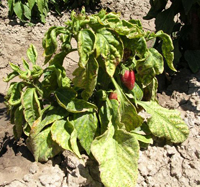 Program-wide notice
Program-wide notice
The Beet Curly Top Virus Control Program (BCTVCP) would like to remind growers to treat any fallow fields and roadside host plants before disking or mowing, to prevent movement of beet leafhoppers into neighboring tomato fields. The program would also like to point out that almonds, pistachios and vineyards often have BLH host plants growing in the middles of each row. In one survey, BLH counts were 20+ (adults and nymphs) on Russian thistle that was growing in the middle of one almond orchard. When those host plants get mowed, it is likely the BLH will move through nearby tomato fields, potentially causing BCTV infection. It is good practice to treat the host plant weeds with an insecticide prior to mowing or disking.
Fresno County
- Program personnel continued mapping fallow fields that have developed abundant Russian thistle which can support significant BLH populations. These fields will be monitored for BLH counts and Russian thistle development for potential fall treatments.
- Mapping of fallow fields will continue with additions and subtractions as the fall treatment campaign draws closer.
- Waivers based on mapped fields were prepared and distributed. A total of 43 waivers were sent.
- Total potential treatment area mapped for Fresno County was 36,954 acres. The total will likely decrease as fallow fields and Russian thistle are disked, causing the beet leafhoppers to concentrate on smaller remaining fields.
- Currently, there is a lot of widespread Russian thistle and BLH counts are low. Average counts are 2 adults per sweep and zero nymphs.
Imperial/Riverside Counties
- Two Russian thistle samples and the BLH that were collected from the Russian thistle was sent for testing. Samples were from Palmdale/Lancaster area. Results were negative for BCTV in both the leafhoppers and the thistle.
- One beet leafhopper sample from Imperial County was positive for BCTV. The BLH were swept from lambsquarter.
Kern County
- Program personnel continued mapping fallow fields that have developed abundant Russian thistle which can support significant BLH populations. These fields will be monitored for BLH counts and Russian thistle development for potential fall treatments.
- Waivers based on mapped fields were prepared and distributed. A total of 120 waivers were sent.
- Total potential treatment aera mapped for Kern County is 17,500 acres. The total will likely decrease as fallow fields and Russian thistle are disked, causing the beet leafhoppers to concentrate on smaller remaining fields.
- The majority of the acreage mapped is located north of Twisselman Road, south along Interstate 5 to Highway 46, and west along Highway 46 to the north county line, along Highway 33.
- Currently, the Russian thistle is spotty and widespread with low BLH counts. Average counts are less than 1 BLH per sweep.
- Two samples of BLH swept from Russian thistle were collected last month and sent for testing. Samples were taken from two fields that were treated in July. Both samples were positive for BCTV.
- The program collected tomato samples for a grower toward the end of July. Two of the ten tomato samples were positive for BCTV. Four pepper samples were also collected. All four pepper samples were negative for BCTV, however, two were positive for TSWV.
Kings County
- Program personnel continued mapping fallow fields that have developed abundant Russian thistle which can support significant BLH populations. These fields will be monitored for BLH counts and Russian thistle development for potential fall treatments.
- Waivers based on mapped fields were prepared and distributed. A total of 13 waivers were sent.
- Total potential treatment area mapped for Kings County is 18,159 acres. The total will likely decrease as fallow fields and Russian thistle are disked, causing the beet leafhoppers to concentrate on smaller remaining fields.
- The majority of mapped fields were located south of Kettleman City, east of Interstate 5 along Utica Avenue. Currently, BLH population counts are low. Average counts are 1 adult BLH per sweep, with an occasional nymph.
- One sample of BLH collected near the beginning of July was sent for testing. The leafhoppers were swept from goosefoot. The sample was positive for BCTV.
Merced County
- One fallow field on the western edge of Dos Palos had a lot of Russian thistle and sparse Bassia. BLH counts were 1-2 adults per sweep and zero nymphs.
- Roadsides along Henry Miller Road west of Carlucci Road along an irrigation ditch had a lot of purslane. BLH counts were 5-7 adults and 3-4 nymphs per sweep.
- Several other fallow fields and roadsides with host plants were monitored over the month. BLH counts were less than 1 per sweep.
- One sample of BLH collected near the beginning of July was sent for testing. The leafhoppers were swept from purslane. The sample was positive for BCTV.
San Joaquin County
- Sweep surveys were conducted in various locations. Beet leafhopper counts were minimal in all locations surveyed, despite having suitable host plants.
- Average counts were 1 adult BLH per sweep and zero nymphs.
- A stretch of stressed Russian thistle from Highway 33 to Highway 132 south to the San Joaquin/Stanislaus County line had counts of 1-3 adult BLH and 1-2 nymphs per sweep.
Stanislaus County
- Fallow fields and roadsides were surveyed for BLH hosts and populations were monitored. BLH counts remain low.
- Russian thistle was spotty in fallow fields and along roadsides. Average counts were 2 adult BLH per sweep and zero nymphs.
- One sample of BLH collected near the beginning of July and sent for testing. The leafhoppers were swept from purslane. The sample was positive for BCTV.










